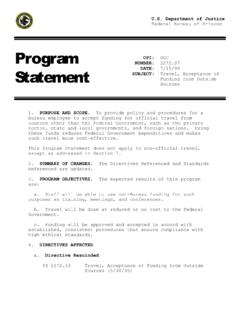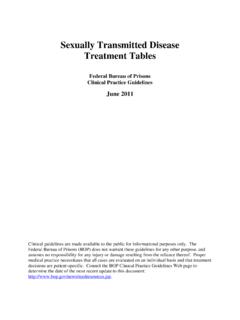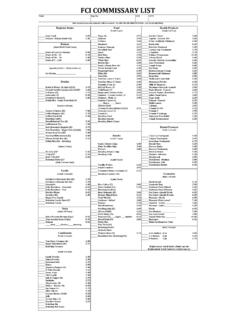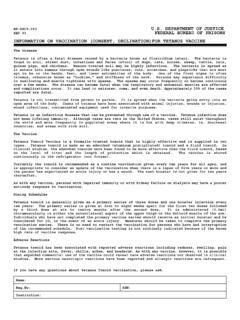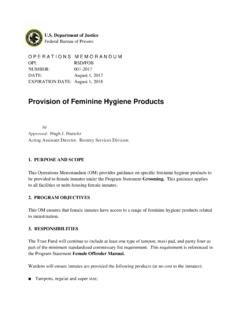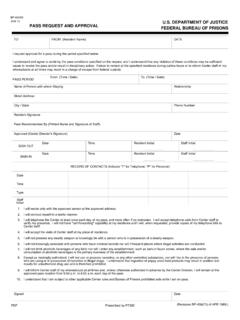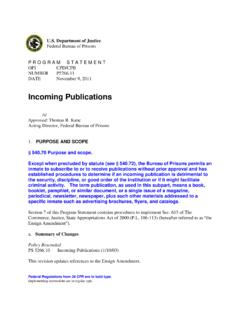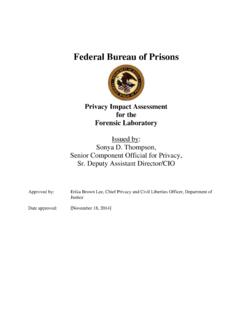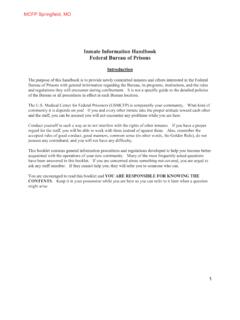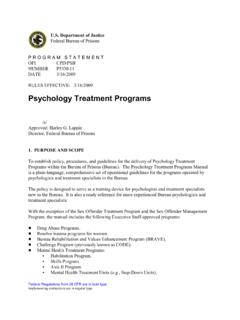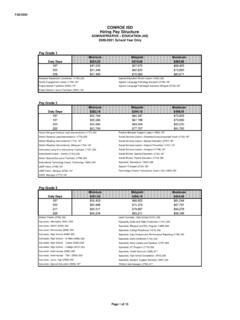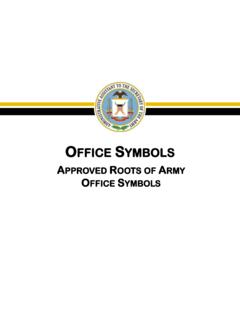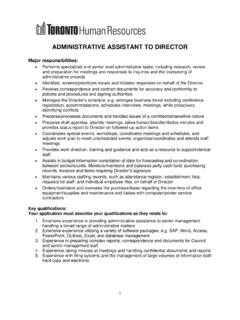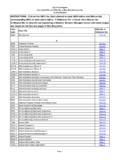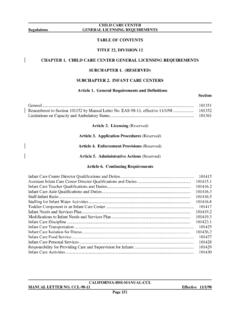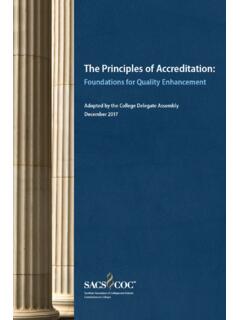Transcription of Special Housing Units - Federal Bureau of Prisons
1 Department of Justice Federal Bureau of Prisons P R O G R A M S T A T E M E N T OPI: CPD/CSB NUMBER: DATE: November 23, 2016 Special Housing Units /s/ Approved: Thomas R. Kane Acting Director, Federal Bureau of Prisons 1. PURPOSE AND SCOPE Purpose. This subpart describes the Federal Bureau of Prisons ( Bureau ) operation of Special Housing Units (SHU) at Bureau institutions. The Bureau s operation of SHUs is authorized by 18 4042(a)(2) and (3). a. Program Objectives. The expected results of this program are: Special Housing Unit placement should always serve a specific penological purpose. Inmates are housed in the least restrictive setting necessary to ensure their own safety, as well as the safety of staff, other inmates, and the public.
2 A safe and orderly environment will be provided for staff and inmates. Living conditions for inmates in disciplinary segregation and administrative detention will meet or exceed applicable standards. Accurate and complete records will be maintained on conditions and events in Special Housing Units . Federal Regulations from 28 CFR are shown in this type. Implementing instructions are shown in this type. 11/23/2016 Federal Regulations are shown in this type. Implementing instructions: this type. 2 b. Summary of Changes Policy Rescinded Special Housing Units (7/29/11) Memorandum from assistant Director Scott Dodrill, Secure Housing Unit Operations, dated 3/2/10 Memorandum from assistant Director Frank Strada, Special Housing Unit Training, dated 4/17/2015 The following changes have been incorporated into the policy: Several changes have been implemented to adhere to Department of Justice recommendations regarding guiding principles.
3 Training standards have been updated. Alternate Clothing guidance is provided. Objectives were defined. Forms have been updated. Circumstances under which pregnant inmates can be placed in SHU have been defined. Psychological concerns regarding SHU placements have been addressed. c. Institution Supplement. None required. Should local facilities make any changes outside the required changes in the national policy or establish any additional local procedures to implement the national policy, the local Union may invoke to negotiate procedures or appropriate arrangements. 2. Special Housing Units (SHUS) Special Housing Units (SHUs). Special Housing Units (SHUs) are Housing Units in Bureau institutions where inmates are securely separated from the general inmate population, and may be housed either alone or with other inmates.
4 Special Housing Units help ensure the safety, security, and orderly operation of correctional facilities, and protect the public, by providing alternative Housing assignments for inmates removed from the general population. For inmates with suspected or confirmed contagious diseases, refer to the Program Statements Intake Screening, Infectious Disease Management, and Patient Care, and, when applicable, the Pandemic Influenza Plan. 11/23/2016 Federal Regulations are shown in this type. Implementing instructions: this type. 3 Alternative segregation Housing arrangements outside the Special Housing Unit itself must be proposed by the Warden to the Regional Director, and ultimately approved by the assistant Director, Correctional Programs Division, before activation.
5 Alternative segregation Housing of this type will only be approved as SHU overflow for inmates in administrative detention or disciplinary segregation status. Operation of such alternative segregation Housing requires compliance with all Bureau rules, policies, staffing, and post orders for operating Special Housing Units . General population inmates are not permitted to enter a secure Housing unit to interact with inmates for dispute resolutions, intelligence gathering, or security threat group/disruptive group meetings. This also applies to removing inmates from a secure Housing unit to meet with inmates in general population. Institution staff must rely on trained investigative techniques, link analysis, and other means of gathering information without allowing inmates into a secure Housing setting to conduct face-to-face meetings with one another.
6 Inmates who are pregnant, who are post-partum (up to 8 weeks), who recently had a miscarriage (up to 4 weeks), or who recently had a terminated pregnancy (up to 4 weeks) should not be placed in restrictive Housing . In rare situations, these inmates may be placed in restrictive Housing as a temporary response to behavior that poses a serious and immediate risk of physical harm or to ensure the safety, security, and orderly running of a BOP facility. 3. STATUS WHEN PLACED IN THE SHU Status when placed in the SHU. When placed in the SHU, you are either in administrative detention status or disciplinary segregation status. (a) administrative detention status. administrative detention status is an administrative status which removes you from the general population when necessary to ensure the safety, security, and orderly operation of correctional facilities, or protect the public.
7 administrative detention status is non-punitive, and can occur for a variety of reasons. The Warden may impose temporarily more restrictive conditions on an inmate (which may be in an area ordinarily set aside for disciplinary segregation and therefore requires the withdrawal of privileges ordinarily afforded in administrative detention status, until a hearing before the DHO can be held) who: 11/23/2016 Federal Regulations are shown in this type. Implementing instructions: this type. 4 Is causing a serious disruption (threatening life, serious bodily harm, or property) in administrative detention. Cannot be controlled within the physical confines of administrative detention. Upon advice of qualified health personnel, does not require confinement in the institution hospital if the institution has one for mental or physical treatment, or who would ordinarily be housed in the institution hospital for mental or physical treatment, but who cannot safely be housed there because the hospital does not have a room or cell with adequate security provisions.
8 Inmate confined under these more restrictive conditions must have their status reviewed and fully documented on a new BP-A0321 every 5 days. The Warden may delegate this authority no further than to the official in charge of the institution when the move is necessary. A fully documented report Special Housing Unit Temporary Restrictive Housing Order (BP- A0321) is maintained in the Inmate Central File. (b) Disciplinary segregation status. Disciplinary segregation status is a punitive status imposed only by a Discipline Hearing Officer (DHO) as a sanction for committing a prohibited act(s). 4. administrative DETENTION STATUS administrative detention status. You may be placed in administrative detention status for the following reasons: (a) Pending Classification or Reclassification.
9 You are a new commitment pending classification or under review for Reclassification. This includes newly arrived inmates from the Bus, Airlift, and Marshals Service. (b) Holdover Status. You are in holdover status during transfer to a designated institution or other destination. (c) Removal from general population. Your presence in the general population poses a threat to life, property, self, staff, other inmates, the public, or to the security or orderly running of the institution and: 11/23/2016 Federal Regulations are shown in this type. Implementing instructions: this type. 5 (1) Investigation. You are under investigation or awaiting a hearing for possibly violating a Bureau regulation or criminal law; (2) Transfer. You are pending transfer to another institution or location; (3) Protection cases.
10 You requested, or staff determined you need, administrative detention status for your own protection; or (4) Post-disciplinary detention. You are ending confinement in disciplinary segregation status, and your return to the general population would threaten the safety, security, and orderly operation of a correctional facility, or public safety. Staff must obtain approval from a Lieutenant or the Captain before placing an inmate in administrative Detention status pending investigation of a disciplinary violation. When considering approval for administrative Detention, the seriousness of the violation should be reviewed. In making Special Housing determination, officials should consider the seriousness of the alleged offense, including whether the offense involved violence, involved escape, or posed a threat to institutional safety or the orderly running of the institution.
